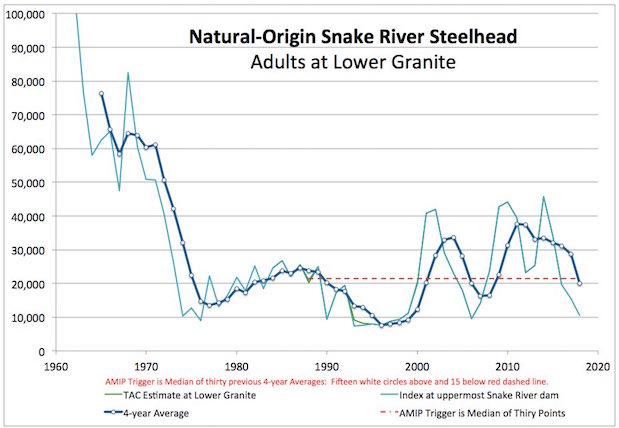forum
library
tutorial
contact

4 Wild Steelhead
Tracked in Marsh Creek
by Staff
Challis Messenger, May 22, 2020
|
the film forum library tutorial contact |

|
4 Wild Steelhead
by Staff
|
"A contributing factor in low steelhead numbers is poor tracking methods," (Oh really?)
 Using a recently installed passive integrated transponder array, Idaho Department of Fish and Game workers tracked four adult wild steelhead salmon returning to Marsh Creek to spawn.
Using a recently installed passive integrated transponder array, Idaho Department of Fish and Game workers tracked four adult wild steelhead salmon returning to Marsh Creek to spawn.
This is promising news, according to a press release from Fish and Game Biologist Eric Stark. Seeing any steelhead returning to Idaho from the ocean to spawn is worth celebrating because of their decreasing numbers, according to Stark.
Since 1995, steelhead have been listed as a threatened species under the Endangered Species Act. In the early and mid-2000s there was a large spike in the fish population, with more than 40,000 steelhead returning to the Snake River every year.
However, in the last four years, Stark said steelhead run numbers have dropped “dramatically” across all of Idaho.
A contributing factor in low steelhead numbers is poor tracking methods, he said. Steelhead spawn in the spring, when Idaho rivers and streams are swollen with melted snow and particulates from the mountains. These conditions make it hard to count steelhead accurately from the shore, Stark said. Weirs can be put in rivers and streams to capture, sample and count steelhead, but because spring flows are so heavy in Idaho a lot of weirs are washed out.
Stark said this is where the new arrays come in.
“These arrays are a very powerful tool, especially in a place like Marsh Creek, which is one of the highest elevation spawning tributaries and as such is nearly inaccessible currently due to the snowpack,” Stark wrote in a news release.
The devices are placed at the bottom of rivers and streams and accurately count fish as they swim over it. They allow biologists to look at return rates and other data over the internet, which Stark said is how biologists detected the four steelhead.
Two of the steelhead were tagged as adults in 2019 and were detected by the Marsh Creek array at the end of April. Stark said workers at the Lower Granite Dam tagged the fish as they returned from the ocean to Idaho, sampling them and measuring one at 27 inches and the other at 28 inches.
The other two steelhead first came up as juveniles emigrating to the ocean, according to Stark. Fish and Game workers captured, tagged and released one of these fish in May 2017 and the other in May 2018. Since then, Stark said workers were able to track them as they spent time in the ocean, one for a year and the other for two years, and as they returned to Idaho.
Stark tracked them as they both passed the Bonneville Dam early last September and as they eventually worked their ways past the last eight dams of the Columbia and Snake rivers in October.
“Since then, they have been slowly making their way up the Snake River to the Salmon River, up the Salmon River to the Middle Fork Salmon River, and eventually to their birthplace in Marsh Creek,” Stark said.
Related Sites:
Poor Steelhead Returns will Likely Impact Small Towns that Bank on Anglers by Staff, Coeur d'Alene Press, 9/6/18
Steelhead Fishing Closed on Large Section of Columbia River by Staff, Coeur d'Alene Press, 9/6/18
States Slash Steelhead Bag Limits by Staff, Lewiston Tribune, 9/2/18
States Close Columbia River to Steelhead Retention by Staff, Columbia Basin Bulletin, 8/30/18
Down to a Trickle; Steelhead Numbers Continue Descent by Staff, Lewiston Tribune, 8/31/18
Oregon Closes Steelhead Sanctuary Off Mouth of Deschutes to All Fishing by Bill Monroe, The Oregonian, 8/8/18
learn more on topics covered in the film
see the video
read the script
learn the songs
discussion forum
